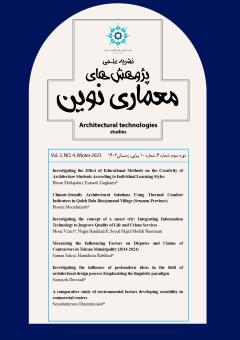A comparative study of environmental factors developing sociability in commercial centers
Subject Areas :
1 - Qazvin Islamic Azad University, Qazvin, Iran.
Keywords: Sociability, Social sustainability, Design of commercial centers, Environmental psychology, Architecture of public centers.,
Abstract :
The city of Tehran, as the capital of Iran, has been undergoing a significant transformation in terms of modern changes and extensive development in public center design. Commercial complexes are considered as common domains for social interactions, communications, and social cognition, reflecting effective urban aspects. However, the neglect of social analysis in the design process may lead to the loss of communication between individuals and public spaces, which can result in undesirable social consequences and psychological and emotional distress within society such as isolation and Social alienation. In this regard, the design and architecture of commercial centers have a prominent role, and further research on the social acceptability of these centers is necessary. The main objective of this comparative research is to examine and compare the influential components of social acceptability based on architectural features in the commercial performance of two different structures, namely traditional market centers and malls. The case studies of this research include the Grand Bazaar of Tehran and Kourosh Mall. This study employs a mixed-method approach, utilizing library research, questionnaires, in-depth interviews, and observations, to investigate the subject both quantitatively and qualitatively. Analysis of the results demonstrates that multi-purpose commercial complexes, through environmental structural factors, possess higher levels of overall acceptability compared to traditional markets, by developing dimensions of greater security. This research contributes to the field of architecture and urban design by highlighting the importance of social analysis in the design process and identifying the influential components of social acceptability in commercial centers.
1- اشرف، احمد(1353). ویژگیهای تاریخی شهرنشینی در ایران. نامه علوم اجتماعی، 1(4)، 7-49.
2- حبیبی، سید محسن(1380). از شار تا شهر. تهران: دانشگاه تهران.
3- حميدی، ملیحه(1376). استخوانبندی شهر تهران. تهران: سازمان مشاور فنی و مهندسی.
4- خیرخواه، مجید؛ و شعاعی، حمیدرضا(۱۳۹۵). معرفی جایگاه و بیان اهمیت مراکز تجاری، با بررسی مجتمع تجاری- فرهنگی هانگزو چین. اولین همایش سراسری مباحث کلیدی در مهندسی عمران، معماری و شهرسازی ایران، گرگان، گروه آموزش و پژوهش شرکت مهندسی باروگستر پارس، دانشگاه فرهنگیان استان گلستان.
5- دانشپور، سید هبدالهادی و چرخچیان، مریم(1386). فضاهای عمومی و عوامل مؤثر بر حیات جمعی. باغ نظر، 4(7)، 19-24.
6- رازقی، علیرضا؛ و درخشانی، نجلا(1394). سنجش نگرش بازاریان نسبت به تاب¬آوری ارزشهای تاریخی- فرهنگی در حفاظت از بازار. مرمت و معماری ایران (مرمت آثار و بافت¬های تاریخی فرهنگی)، 5(10)، 91-103. dor: 20.1001.1.23453850.1394.5.10.7.1
7- شفقی، سیروس(1385). بازار بزرگ اصفهان. اصفهان: سازمان فرهنگی تفریحی شهرداری.
8- شهيدی، حسین(1383). سرگذشت تهران. تهران: راه مانا.
9- فلاحت، محمد صادق(۱۳۸۵). مفهوم حس مکان و عوامل تشکیلدهنده آن. هنرهای زیبا، 26، ۶۶-۵۷.
10- لنگ، جان(1381). آفرینش نظریه معماری: نقش علوم رفتاری در طراحی محیط. ترجمه علیرضا عینی¬فر. تهران: موسسه چاپ و انتشارات دانشگاه تهران.
11- مطلبی، قاسم؛ و جوان فروزنده، علی(1390). مفهوم حس تعلق به مکان و عوامل تشکیل¬دهنده آن. هویت شهر، 5(8)، 27-37.
12- Barker, R. G. (1968). Ecological Psychology: Concepts and Methods for Studying the Environment of Human Behavior. Stanford, CA: Stanford University Press.
13- Hillier, B. (1996). Space is the Machine: A Configurational Theory of Architecture, Cambridge University Press.
14- Hillier, B., Hanson, J., & Peponis, J. (1984). What do we mean by building function?. E & FN Spon Ltd.
15- Lerup, L. (1972). Environmental and behavioral congruence as a measure of goodness in public space: the case of Stockholm. Ekistics, 34(204), 341–358.
16- Marcus, C. C., & Francis, C. (Eds.). (1997). People places: design guidlines for urban open space. John Wiley & Sons.
17- Mohammadi, M., Stevens, Q., & Keane, B. (2022, May). The social life of privately-owned public spaces in Melbourne. 10th State of Australasian Cities National Conference, 1-3 December 2021, Melbourne, Australia.
18- Moleski, W. H., & Lang, J. T. (1982). Organizational Needs and Human Values in Office Planning. Environment and Behavior, 14(3), 319-332. doi:10.1177/0013916582143004
19- Pasalar, C. (2004). The effects of spatial layouts on students' interactions in middle schools: Multiple case analysis. North Carolina State University.
20- Whyte, W. H. (1980). The social life of small urban spaces. Conservation Foundation.


